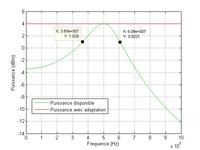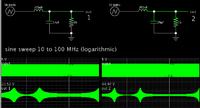perlinpinpin
Newbie level 5

- Joined
- May 23, 2014
- Messages
- 9
- Helped
- 1
- Reputation
- 2
- Reaction score
- 1
- Trophy points
- 3
- Activity points
- 69
Hi,
i like to match 1k(Rch) to 50R(Rs).
I try a simple LC network with C // 1k and L serial.
I found that Qloaded=sqrt((1k/50R) -1) (from Chris Browik "RF design")
So i get a Qloaded of 4.35.
If i use a smith chart and trace the matching procedure the max Q is 4.35
If i calculate LC for a frequence of 50e6Hz (L=687nH and C=14pF), as Qloaded=fo/Bw, Bw is about 11.47MHz.
So now i'd like to perform a sweep from 10 to 100MHz and check the bandwidth of the matching.
I do a script on matlab to do the calculus and graph it.
Basicaly it gives (ZL stand for 1/j*C*2*pi*f and ZL...):
it= current of circuit= V/(Rs+ZL+(Rch//ZC)).
Current flowing into Rch equal it*(ZC/(ZC+Rch)) (current divider)
Power dissipating by Rch should be ((it*/(it))*Rch)/2. (/(it) stand for conjugate of course).
This is that last equation i plot.
I also plot the maximum available power V^2/8Rs (with a matched load 50R).
I'll add plot next time.
The problem is i get the adaptation at 50e6MHz but the bandwidth is wider i get an approximate 25MHz (-3dB bandwidth).
Someone has an idea?
Sincerely,

i like to match 1k(Rch) to 50R(Rs).
I try a simple LC network with C // 1k and L serial.
I found that Qloaded=sqrt((1k/50R) -1) (from Chris Browik "RF design")
So i get a Qloaded of 4.35.
If i use a smith chart and trace the matching procedure the max Q is 4.35
If i calculate LC for a frequence of 50e6Hz (L=687nH and C=14pF), as Qloaded=fo/Bw, Bw is about 11.47MHz.
So now i'd like to perform a sweep from 10 to 100MHz and check the bandwidth of the matching.
I do a script on matlab to do the calculus and graph it.
Basicaly it gives (ZL stand for 1/j*C*2*pi*f and ZL...):
it= current of circuit= V/(Rs+ZL+(Rch//ZC)).
Current flowing into Rch equal it*(ZC/(ZC+Rch)) (current divider)
Power dissipating by Rch should be ((it*/(it))*Rch)/2. (/(it) stand for conjugate of course).
This is that last equation i plot.
I also plot the maximum available power V^2/8Rs (with a matched load 50R).
I'll add plot next time.
The problem is i get the adaptation at 50e6MHz but the bandwidth is wider i get an approximate 25MHz (-3dB bandwidth).
Someone has an idea?
Sincerely,



